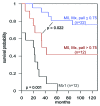The mesenchymal tumor microenvironment: a drug-resistant niche
- PMID: 22568991
- PMCID: PMC3427243
- DOI: 10.4161/cam.20210
The mesenchymal tumor microenvironment: a drug-resistant niche
Abstract
Drug and radiation resistance represent a challenge for most anticancer therapies. Diverse experimental approaches have provided evidence that the tumor-associated microenvironment constitutes both a protective shell that impedes drug or radiation access and a permissive or promotive microenvironment that encourages a nurturing cancer (i.e., cancer stem cell) niche where tumor cells overcome treatment- and cancer-induced stresses. Better understanding of the effects of the tumor microenvironment on cancer cells before, during and immediately after chemo- or radiotherapy is imperative to design new therapies aimed at targeting this tumor-protective niche. This review summarizes some of the known mesenchymal stromal effects that account for drug resistance, the main signal transduction pathways associated with this resistance and the therapeutic efforts directed to increase the success of current therapies. Special emphasis is given to environment-mediated drug resistance in general and to cell adhesion-mediated drug resistance in particular.
Figures


References
-
- Borowitz MJ, Devidas M, Hunger SP, Bowman WP, Carroll AJ, Carroll WL, et al. Children’s Oncology Group Clinical significance of minimal residual disease in childhood acute lymphoblastic leukemia and its relationship to other prognostic factors: a Children’s Oncology Group study. Blood. 2008;111:5477–85. doi: 10.1182/blood-2008-01-132837. - DOI - PMC - PubMed
Publication types
MeSH terms
Substances
Grants and funding
LinkOut - more resources
Full Text Sources
